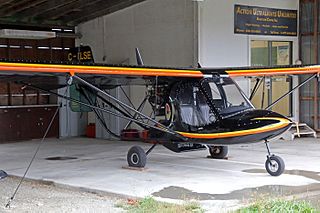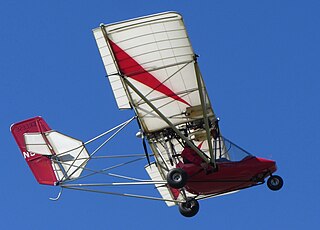Related Research Articles
The Advanced Aviation Explorer is a two-seat ultralight marketed in kit form, for amateur construction. It is a high-wing taildragger aircraft of pusher configuration with tandem seating.

The Weedhopper is an American high-wing, tractor configuration, tricycle gear, two-axis control ultralight aircraft originally developed by John Chotia during the height of the 1970s ultralight boom and introduced in 1977. When it was in production the aircraft was sold as a kit for amateur construction and could be assembled in 25-30 man-hours.
The Fisher FP-505 Skeeter is a Canadian single-seat, conventional landing gear, single-engined parasol-wing monoplane kit aircraft designed for construction by amateur builders. Fisher Flying Products was originally based in Edgeley, North Dakota, USA but the company is now located in Woodbridge, Ontario, Canada.
The Fisher FP-606 Sky Baby is a Canadian single-seat, conventional landing gear or tricycle landing gear-equipped, single-engined, high-wing monoplane kit aircraft designed for construction by amateur builders. Fisher Flying Products was originally based in Edgeley, North Dakota, USA but the company is now located in Woodbridge, Ontario, Canada.

The CGS Hawk is a family of high wing, strut-braced, pusher configuration, single and two-seats-in-tandem ultralight aircraft, designed by Chuck Slusarczyk and manufactured by CGS Aviation.
The Excalibur is an American two seats-in-tandem, high wing, pusher configuration ultralight aircraft that is manufactured in kit form for amateur construction, by Excalibur Aircraft of Sebring, Florida. It was introduced in 1993.

The Sorrell Hiperlight is a family of single and two seat, negative stagger biplanes, designed for amateur construction.
The Kolb Kolbra and King Kolbra are a family of American tandem two seater, high wing, strut-braced, pusher configuration, conventional landing gear-equipped ultralight aircraft that are produced in kit form by New Kolb Aircraft of London, Kentucky and intended for amateur construction.
The Flying K Sky Raider is a family of American, high wing, strut-braced, single engine, conventional landing gear ultralight aircraft that was designed by Ken Schrader and produced by Flying K Enterprises and later Sky Raider LLC of Caldwell, Idaho for amateur construction.
The Loehle SPAD XIII is an American single-seat ultralight aircraft scale replica of the First World War SPAD XIII fighter produced in kit form by Loehle Aircraft for amateur construction.

The Carlson Sparrow is a family of American, high wing, strut-braced, single engine, ultralight aircraft that was designed by Ernst W. Carlson and produced by Carlson Aircraft of East Palestine, Ohio and later Skyline Technologies of Salem, Ohio for amateur construction.

The Earthstar Thunder Gull is a family of cantilever high-wing, tricycle gear ultralight aircraft, manufactured by Earthstar Aircraft of Santa Margarita, California as a kit for amateur construction or as a completed aircraft.

The Bailey-Moyes Dragonfly is an Australian-American two-seats-in-tandem, high-wing, strut-braced, open cockpit, conventional landing gear-equipped ultralight aircraft. The aircraft has been in production since 1990 and was designed as a special-purpose tug for hang gliders and ultralight sailplanes. It is available as a complete aircraft or as a kit for amateur construction. The aircraft has been variously produced by Moyes Microlights, Bailey-Moyes Microlights and currently LiteFlite of Botany, New South Wales, all different iterations of the same company.

The Falconar Golden Hawk is a Canadian tandem seat, pusher configuration, tricycle gear, canard-equipped ultralight aircraft that is offered in kit form by Falconar Avia of Edmonton, Alberta.

The Quicksilver GT500 is a family of American strut-braced, high-wing, pusher configuration, tricycle gear aircraft built by Quicksilver Aeronautics of Temecula, California. The aircraft is available as a kit for amateur construction or as a completed ready-to-fly aircraft.

The SlipStream Genesis is a family of American, strut-braced, high wing, pusher configuration, tricycle gear aircraft, produced in kit form, for amateur construction. Designed by Chuck Hamilton, the series were originally produced by Innovation Engineering of Davenport, Iowa and more recently by SlipStream International of Wautoma, Wisconsin.
The Arnet Pereyra Sabre II is an American, two-seats in side-by-side configuration, conventional landing gear-equipped, strut-braced, high-wing ultralight trainer that was produced by Arnet Pereyra Inc of Rockledge, Florida in kit form for amateur construction.

The M-Squared Breese is a large family of high-wing, strut-braced, pusher configuration, tricycle gear, ultralight aircraft produced by M-Squared Aircraft of St. Elmo, Alabama in kit form, for amateur construction.
The TeST TST-3 Alpin T is a Czech shoulder-wing, T-tailed, single-seat glider and motor glider that was designed and produced by TeST of Brno.
The Howland H-3 Pegasus is an American ultralight aircraft that was designed by Bert Howland and made available by Howland Aero Design in the form of plans for amateur construction, with kits provided by Aircraft Spruce & Specialty Co. The H-3 first flew in 1988.
References
- 1 2 Downey, Julia: 2002 Kit Aircraft Directory, Kitplanes, Volume 18, Number 12, December 2001, page 71 & 85. Kitplanes Acquisition Company. ISSN 0891-1851
- 1 2 Newby-Gonzalez, Tori: 2004 Kit Aircraft Directory, Kitplanes, Volume 20, Number 12, December 2003, page 80. Belvoir Publications. ISSN 0891-1851
- 1 2 3 4 5 6 Cliche, Andre: Ultralight Aircraft Shopper's Guide 8th Edition, page B-84. Cybair Limited Publishing, 2001. ISBN 0-9680628-1-4
- ↑ US Light Aircraft (March 2008). "The Sport Pilot certificate is now a reality". Archived from the original on 28 March 2008. Retrieved 7 February 2011.
- 1 2 3 Downey, Julia: 1999 Kit Aircraft Directory, Kitplanes, Volume 15, Number 12, December 1998, page 74. Primedia Publications. ISSN 0891-1851
- ↑ Downey, Julia: 2001 Kit Aircraft Directory, Kitplanes, Volume 17, Number 12, December 2000, page 79. Kitplanes Acquisition Company. ISSN 0891-1851
- 1 2 3 4 5 Purdy, Don: AeroCrafter - Homebuilt Aircraft Sourcebook, page 278. BAI Communications. ISBN 0-9636409-4-1
- 1 2 Bertrand, Noel; Rene Coulon; et al: World Directory of Leisure Aviation 2003-04, pages 22–23. Pagefast Ltd, Lancaster OK, 2003. ISSN 1368-485X
- ↑ Bayerl, Robby; Martin Berkemeier; et al: World Directory of Leisure Aviation 2011-12, page 66. WDLA UK, Lancaster UK, 2011. ISSN 1368-485X
- ↑ Higher Class Aviation and Oklahoma Light Aircraft. "Sport Hornet website". Archived from the original on 3 July 2007. Retrieved 5 August 2012.
- ↑ US Light Aircraft (March 2008). "Airframe". Archived from the original on 31 May 2007. Retrieved 7 February 2011.
- ↑ US Light Aircraft (March 2008). "Super Hornet". Archived from the original on 31 May 2007. Retrieved 7 February 2011.